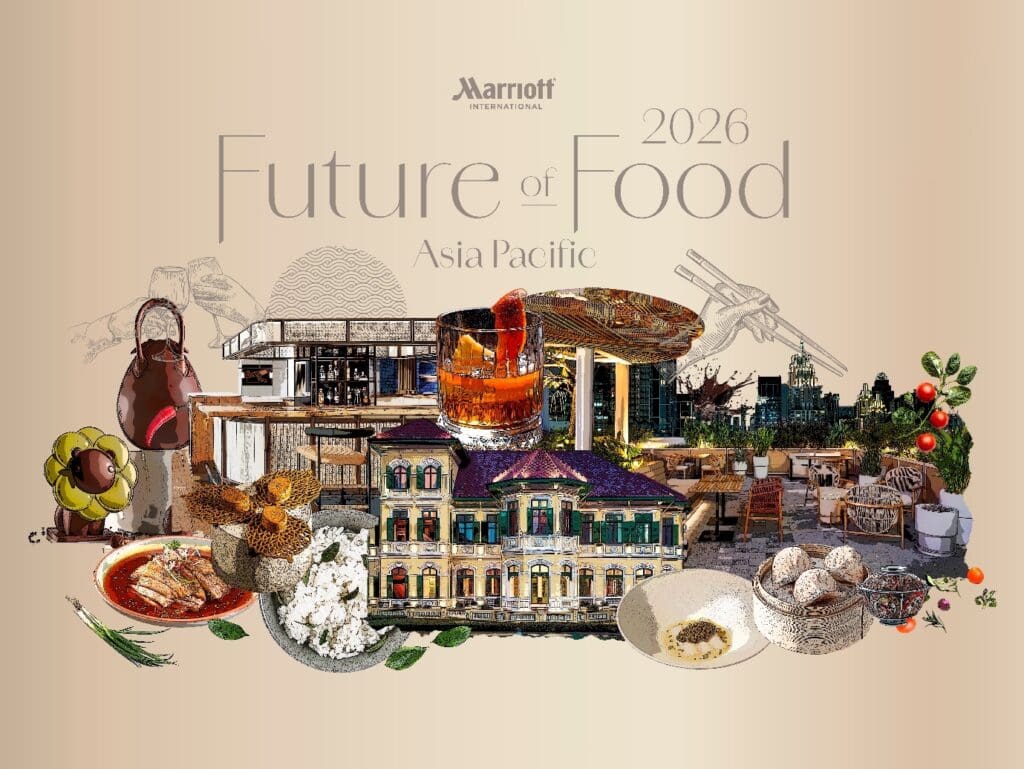Marriott International has unveiled its latest report, The Future of Food 2026, which explores how dining habits and preferences are changing across the Asia Pacific region.
The comprehensive study spotlights major trends reshaping the culinary landscape, including a shift away from traditional fine dining toward casual luxury, comfort-driven menus, immersive dining experiences and a renewed reverence for local flavours. Diners are increasingly prioritizing relaxed, personalized encounters where storytelling, entertainment, and thoughtful design are just as important as the food itself.
Drawing on insights from over 30 influential chefs, mixologists, industry insiders and regional food media, along with findings from Marriott’s inaugural regional survey of F&B teams in 270 properties across 20 Asia Pacific markets, the report explores how these emerging trends are redefining hospitality and guest expectations.
“The Future of Food 2026 showcases how Asia Pacific continues to shape the future of global dining,” says Petr Raba, Vice President of Food & Beverage, Asia Pacific excluding China, Marriott International. “From the rise of casual luxury to experience-focused dining, today’s guests are seeking emotional connection as much as culinary excellence. This report reflects our ongoing commitment to evolving with the industry and delivering dining experiences that are culturally relevant, rooted in place, and reimagined for a new generation of travellers.”
He added, “Across Asia, a new culinary language is emerging, one where quality meets comfort, luxury meets experience, and a meal is no longer just about eating, but about engaging all the senses. As our report shows, food is no longer just fuel; it’s a form of storytelling, identity, and cultural connection.”
Key Trends Shaping the Future of Food
Comfort is the New Luxury
A new era of dining is emerging with the rise of “fine-casual” where comfort food meets creative refinement. From elevated takes on beloved classics, such as caviar-topped fried chicken, to à la carte menus offering more choice and personality, chefs from Singapore to Tokyo are embracing a more relaxed yet luxurious approach. As diners crave familiarity with a twist, high-profile chefs are reimagining everyday favourites with fine-dining finesse, creativity, and visual appeal. Traditional multi-course menus are giving way to faster, more flexible experiences. 59% of Marriott International properties surveyed across Asia Pacific said guests are opting for casual dining experiences over formal ones compared to last year.
Dining Becomes a Sensory Journey
Throughout Asia, dining is turning into a feast for all the senses, with guests choosing to dine in the dark or indulge in edible art. Nearly half (48%) of Marriott International F&B associates report an increase in guests seeking interactive dining experiences compared to the previous year. From omakase journeys to themed environments, restaurants are embracing interactivity and theatricality to create immersive, multisensory experiences. As the lines between retail, hospitality, and entertainment continue to blur, food is becoming a powerful vehicle for identity and creative expression.
Plating Up Native Ingredients
Chefs are embracing indigenous ingredients as integral components of their culinary identity, drawing on heritage and personal expression. There’s a growing emphasis on sourcing local, foraged and often forgotten ingredients to tell richer, more authentic food stories. Among the Marriott International properties surveyed in Asia Pacific, 85% now incorporate locally sourced ingredients or dishes into their offerings, signalling a growing appetite for seasonal food.
AI Takes a Byte of the Industry
As AI becomes more embedded into the hospitality industry, it promises greater efficiency and highly personalized dining experiences. Advancements in technology will drive AI-powered menu engineering, leveraging real-time feedback and to optimize dish combinations and pricing. Of the Marriott International properties surveyed across Asia Pacific, 76% are adopting booking management technologies, while 75% report that social media influences guest decisions around restaurant and bar bookings. While operators embrace these tools to automate tasks and enhance service, a key challenge remains in maintaining the human connection that defines true hospitality.
Asia’s Culinary Hotspots
Indonesia, the Philippines, Vietnam, and Mainland China are gaining international recognition for their vibrant and diverse food cultures. The report explores how these destinations are stepping onto the global culinary stage with renewed confidence and creativity.
Third-Generation Asian Chefs Stir the Pot
Trained in Michelin-starred kitchens, a new wave of third-generation chefs is revolutionizing Asian cuisines. Acting as cultural ambassadors, they employ modern cooking techniques and engage with native ingredients to elevate and refine the cuisine. They are not just cooking; they are preserving heritage while charting a new course, proving that tradition and innovation can coexist harmoniously on the plate. This creative spirit extends to street vendors – or ‘hawkerpreneurs’ – who are adding luxe to laksa and sass to satays.
Additional Report Highlights:
- The Flavour Spectrum: Survey results reveal a preference for both classic cocktails and modern, regionally-inspired mixes. The data also indicates a clear trend toward healthier eating. Across the Asia Pacific, Marriott International’s F&B associates are noticing guests increasingly seeking vegan (63%), vegetarian (64%), and gluten-free (54%) options. In addition, classic condiments like ketchup, mayonnaise, hot sauce, and soy sauce remain popular across most markets.
- Raising the Bar: Bars throughout Asia are redefining the drinking experience, catering to a generation that values wellness, personalization, and immersive environments. From low- or no-alcohol menus to omakase-style cocktails, venues are moving beyond traditional drink service and attracting kindred spirits. Cocktail bars are also shaking up the scene, spilling the tea and spicing up flavours with native ingredients or a dash of Dashi.
- The Future Larder: Bold new ingredients and long-forgotten favourites are driving a new era in Asian cuisine. From fermented condiments to artisanal salts and heritage vinegars, chefs are diving into traditional ingredients to create bold, sustainable flavours with deep cultural significance.
- Sustainability Pioneers: Local heroes are driving sustainable food movements in Asia by empowering local farmers and promoting biodiversity through social enterprises. Their grassroots campaign is inspiring a cultural shift in the hospitality industry and influencing the future of the region’s wider food ecosystem.


